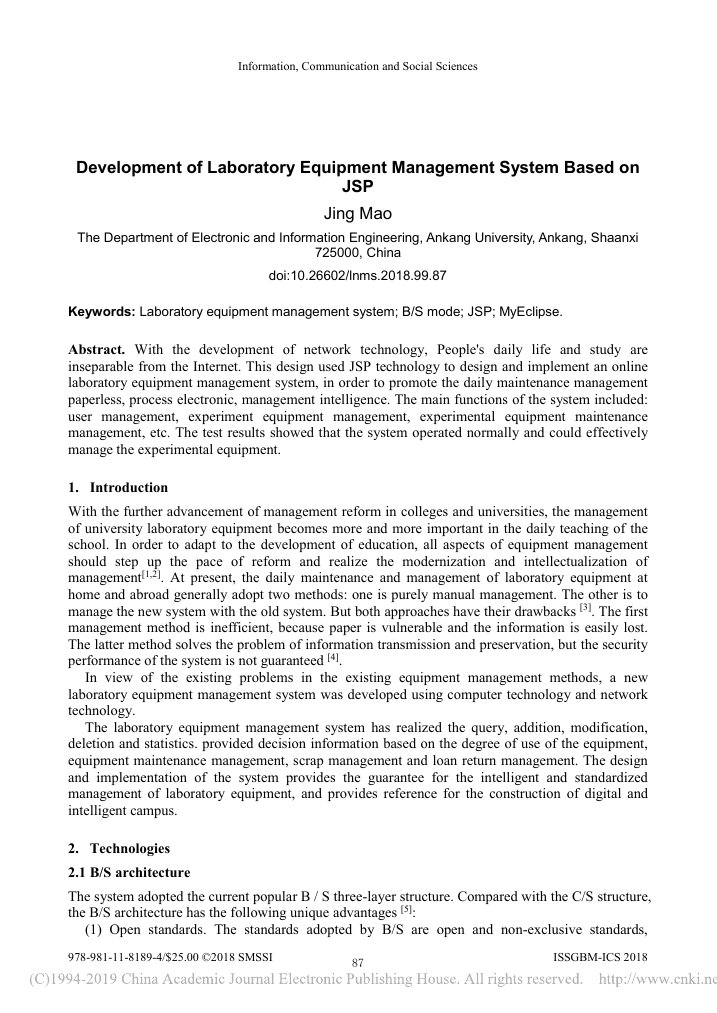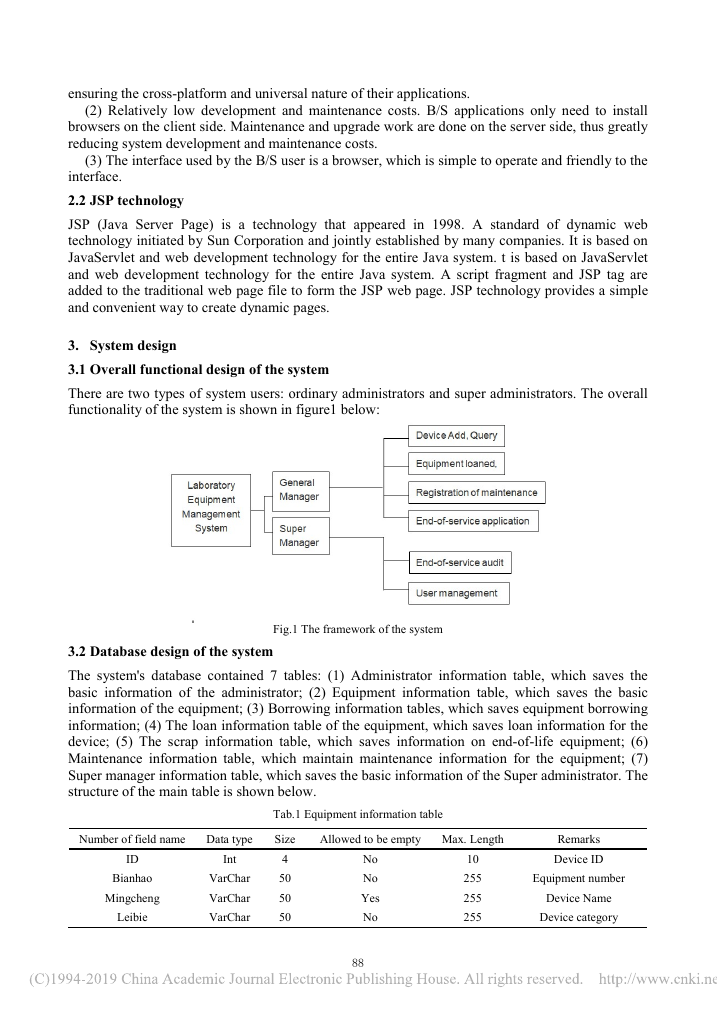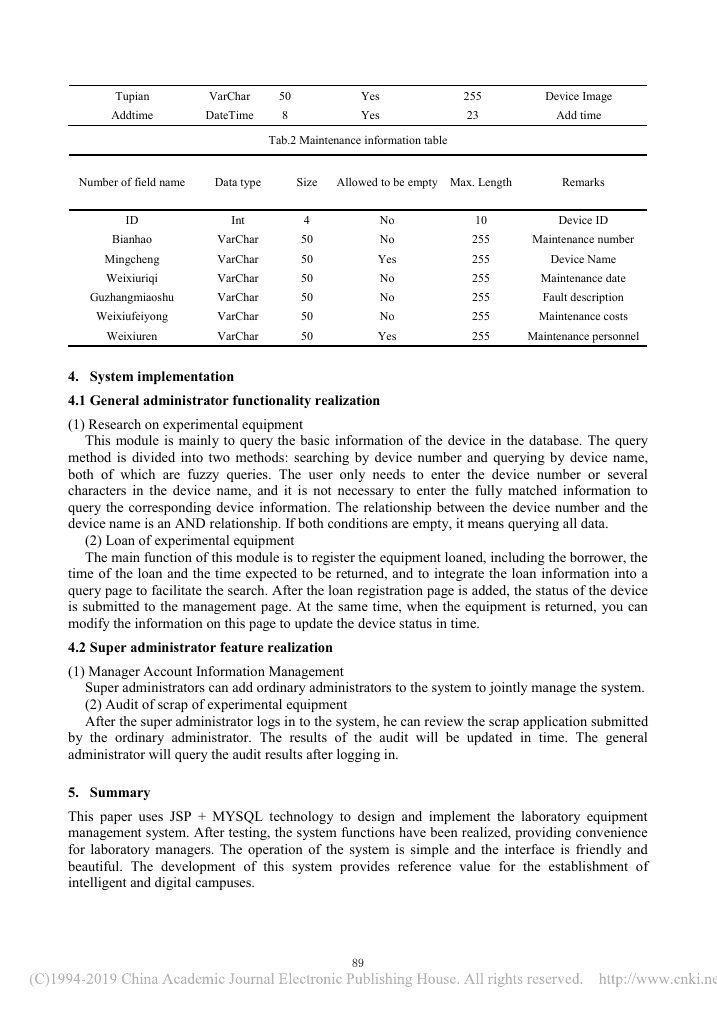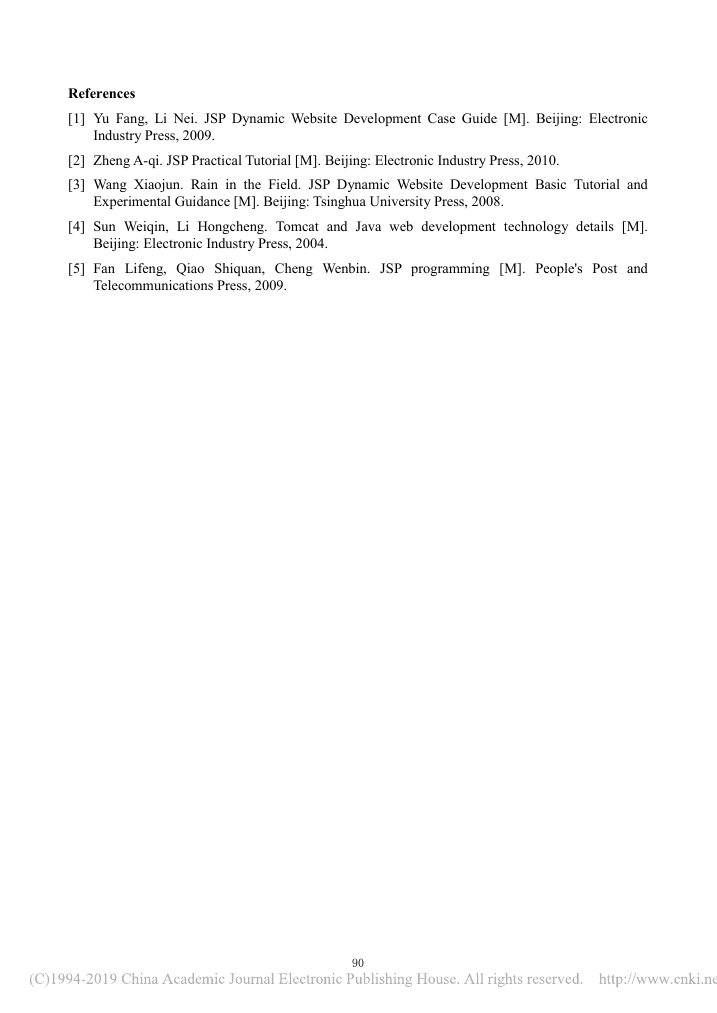Development of Laboratory Equipment Management System Based on JSP Jing Mao The Department of Electronic and Information Engineering, Ankang University, Ankang, Shaanxi 725000, China doi:10.26602/lnms.2018.99.87 Keywords: Laboratory equipment management system; B/S mode; JSP; MyEclipse. Abstract. With the development of network technology, People's daily life and study are inseparable from the Internet. This design used JSP technology to design and implement an online laboratory equipment management system, in order to promote the daily maintenance management paperless, process electronic, management intelligence. The main functions of the system included: user management, experiment equipment management, experimental equipment maintenance management, etc. The test results showed that the system operated normally and could effectively manage the experimental equipment. 1. Introduction With the further advancement of management reform in colleges and universities, the management of university laboratory equipment becomes more and more important in the daily teaching of the school. In order to adapt to the development of education, all aspects of equipment management should step up the pace of reform and realize the modernization and intellectualization of management[1,2]. At present, the daily maintenance and management of laboratory equipment at home and abroad generally adopt two methods: one is purely manual management. The other is to manage the new system with the old system. But both approaches have their drawbacks [3]. The first management method is inefficient, because paper is vulnerable and the information is easily lost. The latter method solves the problem of information transmission and preservation, but the security performance of the system is not guaranteed [4]. In view of the existing problems in the existing equipment management methods, a new laboratory equipment management system was developed using computer technology and network technology. The laboratory equipment management system has realized the query, addition, modification, deletion and statistics. provided decision information based on the degree of use of the equipment, equipment maintenance management, scrap management and loan return management. The design and implementation of the system provides the guarantee for the intelligent and standardized management of laboratory equipment, and provides reference for the construction of digital and intelligent campus. 2. Technologies 2.1 B/S architecture The system adopted the current popular B / S three-layer structure. Compared with the C/S structure, the B/S architecture has the following unique advantages [5]: (1) Open standards. The standards adopted by B/S are open and non-exclusive standards, Information, Communication and Social Sciences 978-981-11-8189-4/$25.00 ©2018 SMSSI ISSGBM-ICS 2018 87�
ensuring the cross-platform and universal nature of their applications. (2) Relatively low development and maintenance costs. B/S applications only need to install browsers on the client side. Maintenance and upgrade work are done on the server side, thus greatly reducing system development and maintenance costs. (3) The interface used by the B/S user is a browser, which is simple to operate and friendly to the interface. 2.2 JSP technology JSP (Java Server Page) is a technology that appeared in 1998. A standard of dynamic web technology initiated by Sun Corporation and jointly established by many companies. It is based on JavaServlet and web development technology for the entire Java system. t is based on JavaServlet and web development technology for the entire Java system. A script fragment and JSP tag are added to the traditional web page file to form the JSP web page. JSP technology provides a simple and convenient way to create dynamic pages. 3. System design 3.1 Overall functional design of the system There are two types of system users: ordinary administrators and super administrators. The overall functionality of the system is shown in figure1 below: Fig.1 The framework of the system 3.2 Database design of the system The system's database contained 7 tables: (1) Administrator information table, which saves the basic information of the administrator; (2) Equipment information table, which saves the basic information of the equipment; (3) Borrowing information tables, which saves equipment borrowing information; (4) The loan information table of the equipment, which saves loan information for the device; (5) The scrap information table, which saves information on end-of-life equipment; (6) Maintenance information table, which maintain maintenance information for the equipment; (7) Super manager information table, which saves the basic information of the Super administrator. The structure of the main table is shown below. Tab.1 Equipment information table Number of field name Data type Size Allowed to be empty Max. Length Remarks ID Int 4 No 10 Device ID Bianhao VarChar 50 No 255 Equipment number Mingcheng VarChar 50 Yes 255 Device Name Leibie VarChar 50 No 255 Device category 88�
Tupian VarChar 50 Yes 255 Device Image Addtime DateTime 8 Yes 23 Add time Tab.2 Maintenance information table Number of field name Data type Size Allowed to be empty Max. Length Remarks ID Int 4 No 10 Device ID Bianhao VarChar 50 No 255 Maintenance number Mingcheng VarChar 50 Yes 255 Device Name Weixiuriqi VarChar 50 No 255 Maintenance date Guzhangmiaoshu VarChar 50 No 255 Fault description Weixiufeiyong VarChar 50 No 255 Maintenance costs Weixiuren VarChar 50 Yes 255 Maintenance personnel 4. System implementation 4.1 General administrator functionality realization (1) Research on experimental equipment This module is mainly to query the basic information of the device in the database. The query method is divided into two methods: searching by device number and querying by device name, both of which are fuzzy queries. The user only needs to enter the device number or several characters in the device name, and it is not necessary to enter the fully matched information to query the corresponding device information. The relationship between the device number and the device name is an AND relationship. If both conditions are empty, it means querying all data. (2) Loan of experimental equipment The main function of this module is to register the equipment loaned, including the borrower, the time of the loan and the time expected to be returned, and to integrate the loan information into a query page to facilitate the search. After the loan registration page is added, the status of the device is submitted to the management page. At the same time, when the equipment is returned, you can modify the information on this page to update the device status in time. 4.2 Super administrator feature realization (1) Manager Account Information Management Super administrators can add ordinary administrators to the system to jointly manage the system. (2) Audit of scrap of experimental equipment After the super administrator logs in to the system, he can review the scrap application submitted by the ordinary administrator. The results of the audit will be updated in time. The general administrator will query the audit results after logging in. 5. Summary This paper uses JSP + MYSQL technology to design and implement the laboratory equipment management system. After testing, the system functions have been realized, providing convenience for laboratory managers. The operation of the system is simple and the interface is friendly and beautiful. The development of this system provides reference value for the establishment of intelligent and digital campuses. 89�
References [1] Yu Fang, Li Nei. JSP Dynamic Website Development Case Guide [M]. Beijing: Electronic Industry Press, 2009. [2] Zheng A-qi. JSP Practical Tutorial [M]. Beijing: Electronic Industry Press, 2010. [3] Wang Xiaojun. Rain in the Field. JSP Dynamic Website Development Basic Tutorial and Experimental Guidance [M]. Beijing: Tsinghua University Press, 2008. [4] Sun Weiqin, Li Hongcheng. Tomcat and Java web development technology details [M]. Beijing: Electronic Industry Press, 2004. [5] Fan Lifeng, Qiao Shiquan, Cheng Wenbin. JSP programming [M]. People's Post and Telecommunications Press, 2009. 90�








 2023年江西萍乡中考道德与法治真题及答案.doc
2023年江西萍乡中考道德与法治真题及答案.doc 2012年重庆南川中考生物真题及答案.doc
2012年重庆南川中考生物真题及答案.doc 2013年江西师范大学地理学综合及文艺理论基础考研真题.doc
2013年江西师范大学地理学综合及文艺理论基础考研真题.doc 2020年四川甘孜小升初语文真题及答案I卷.doc
2020年四川甘孜小升初语文真题及答案I卷.doc 2020年注册岩土工程师专业基础考试真题及答案.doc
2020年注册岩土工程师专业基础考试真题及答案.doc 2023-2024学年福建省厦门市九年级上学期数学月考试题及答案.doc
2023-2024学年福建省厦门市九年级上学期数学月考试题及答案.doc 2021-2022学年辽宁省沈阳市大东区九年级上学期语文期末试题及答案.doc
2021-2022学年辽宁省沈阳市大东区九年级上学期语文期末试题及答案.doc 2022-2023学年北京东城区初三第一学期物理期末试卷及答案.doc
2022-2023学年北京东城区初三第一学期物理期末试卷及答案.doc 2018上半年江西教师资格初中地理学科知识与教学能力真题及答案.doc
2018上半年江西教师资格初中地理学科知识与教学能力真题及答案.doc 2012年河北国家公务员申论考试真题及答案-省级.doc
2012年河北国家公务员申论考试真题及答案-省级.doc 2020-2021学年江苏省扬州市江都区邵樊片九年级上学期数学第一次质量检测试题及答案.doc
2020-2021学年江苏省扬州市江都区邵樊片九年级上学期数学第一次质量检测试题及答案.doc 2022下半年黑龙江教师资格证中学综合素质真题及答案.doc
2022下半年黑龙江教师资格证中学综合素质真题及答案.doc